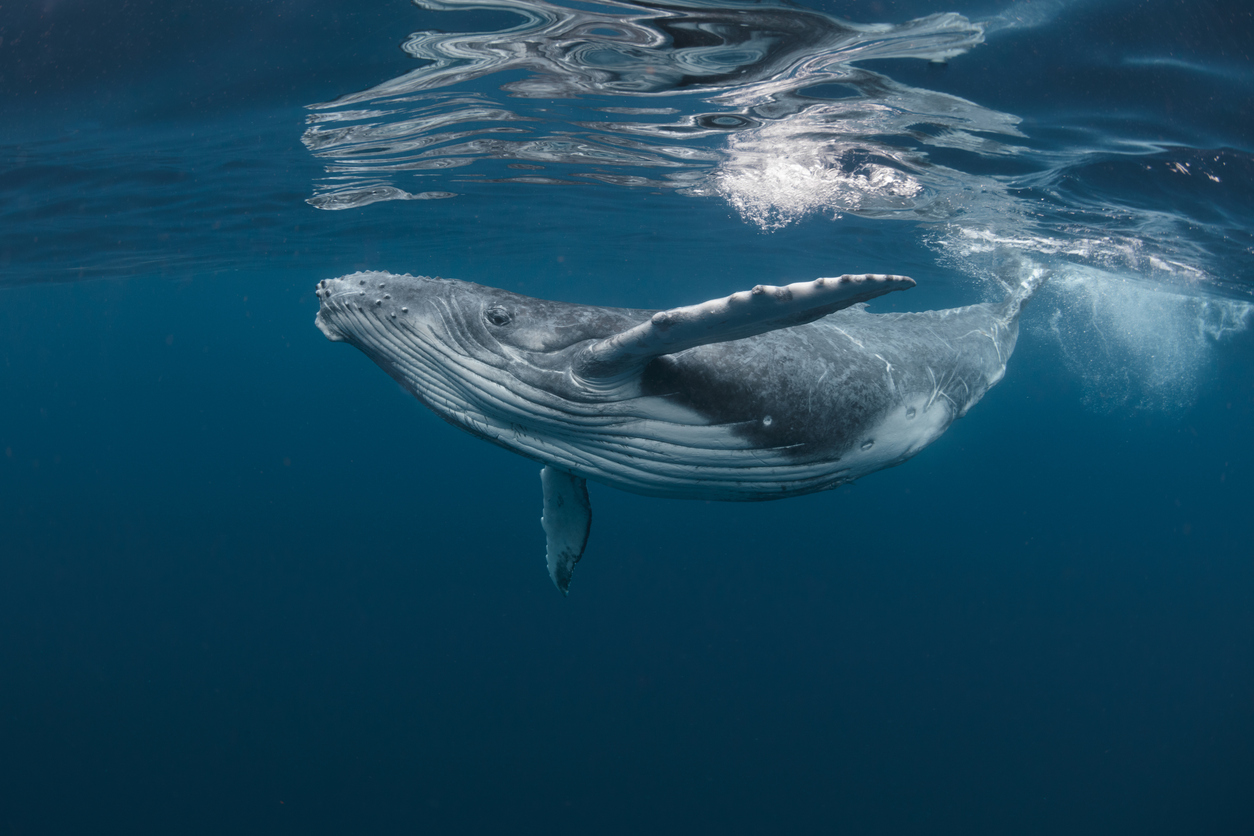
Vibhuti PathakBy: Vibhuti Pathak
In an unprecedented scientific breakthrough, marine biologists have successfully communicated with a humpback whale, demonstrating the potential for cooperation and understanding between humans and these majestic ocean creatures.
The groundbreaking encounter took place in Southeast Alaska, where an adult female humpback whale, known as Twain, responded to a recording of another humpback’s “whup/throp” call.
The recording used in the trial had been made by whales in the same group the previous day. The researchers aimed to understand whether the calls were from Twain or part of an exchange between multiple whales. Over two days, they tested the social acceptability of the recorded whup calls by broadcasting them to Twain and observing her reaction.
The experiment proved successful, as Twain found the calls appropriate and engaged with the team both physically and acoustically in three distinct phases: engagement, agitation, and disengagement. During the engagement phase, she responded to the playback, circling the boat three times before surfacing and diving again. After this interaction, she gradually left.
Scientists acoustically analysed Twain’s whup calls on both days, examining spectral and temporal features such as the inter-call interval, which is the latency between consecutive calls. This metric provided insight into Twain’s emotional state during the exchange, revealing significant variation in her calling behaviour, which suggested excitement or arousal.
“After playing the contact call three times, we got this huge response,” said researcher Brenda McCowan to the BBC. “To keep the animal engaged, I started trying to match the latency of her calls to our calls. So, if she waited 10 seconds, I waited 10 seconds. We ended up matching each other. We did this 36 times over 20 minutes.”
Twain’s calls were notably shorter during the engagement phase compared to the agitation phase when she circled the boat and ejected air through her blowhole, or the disengagement phase when she was preparing to leave.
The experiment’s success was further validated by independent observers who were unaware of the trial’s objectives and reported on Twain’s surface behaviour and respiratory activity.
This groundbreaking study opens up new possibilities for understanding and interacting with humpback whales and other marine species. The complexity of humpback whale songs, among the most intricate in the animal kingdom, offers further opportunities for researchers to explore these animals’ social behaviours and emotional states.
This feature on whale communication and interaction marks a significant step forward in our ability to engage with marine life and expand our knowledge of the natural world.

But why humpback whales were selected?
The humpback whale renowned for their captivating presence and mesmerising songs, is a species of baleen whale that enchants the world with its complex vocalisations. These remarkable creatures, particularly the males, produce intricate songs during the winter breeding season, often lasting anywhere from 4 to 33 minutes and resonating across vast distances. The sounds range in frequency between 100 Hz and 4 kHz, with harmonics reaching up to 24 kHz or more, and can travel at least 10 km (6.2 miles).
Humpback whale songs are structured into layers, including subunits, units, subphrases, phrases, and themes. Subunits are the inflections or discontinuities within a sound, while full units resemble musical notes. A series of units forms a subphrase, and a sequence of subphrases makes up a phrase. Similar phrases are repeated in themes, and multiple themes come together to create the whale’s song.
The purpose of these melodic vocalisations has sparked lively debate among marine scientists. While the primary function remains uncertain, it is thought that the songs may serve multiple purposes. Unlike some species, there is little evidence to suggest that the songs establish dominance among males. However, observations of non-singing males interrupting singers could indicate aggression.
Females may not typically approach solo singers but may be drawn to gatherings of males, reminiscent of a lek mating system. Some believe the songs may attract foreign whales to the breeding grounds or serve as echolocating signals to locate other whales.
Interestingly, a 2023 study revealed that as humpback whale populations have rebounded from whaling, their singing has become less frequent. Yet, their songs retain an enchanting quality, captivating those lucky enough to hear them.
Humpback whale songs are consistent among males in a specific region, with slight alterations over time. These changes can spread horizontally across neighbouring populations throughout successive breeding seasons. In the northern hemisphere, the evolution of songs tends to be more gradual, while in the southern hemisphere, the songs undergo cyclical revolutions.
Beyond their iconic songs, humpback whales are known to produce a variety of other vocalizations. “Snorts” are quick, low-frequency sounds often heard among groups with mother-calf pairs and male escorts, likely mediating interactions within the group. “Grumbles,” on the other hand, are longer-lasting, low-frequency sounds commonly made by groups with adult males, possibly signalling body size and social status.
Additionally, humpback whales emit frequency-modulated “thwops” and “wops” that may function as contact calls within and between groups. High-pitched “cries” and “violins,” as well as modulated “shrieks,” are associated with competition among groups with two or more males. When joining new groups, humpback whales may produce short, low-frequency “grunts” and short, modulated “barks.”
The humpback whale’s rich vocalizations, from its melodic songs to its diverse range of sounds, continue to captivate the imagination and inspire a sense of wonder in all who encounter them. These majestic giants of the sea remind us of the intricate and beautiful connections shared across the animal kingdom.